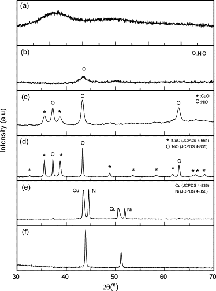| Cangiano et. al. demonstrate the viability of producing Cu–Ni alloy nanoparticles of homogeneous composition via a four-step, citrate-gel process with significantly reduced reaction temperatures. |
Reviewed by Linyang Wang, NSC Technology
- Cangiano, M. de los A., Carreras, A. C., Ojeda, M. W., and Ruiz, M. del C. A new chemical route to synthesize Cu-Ni alloy nanostructured particles. Journal of Alloys and Compounds 458 (2008) 405-409. DOI: 10.1016/j.jallcom.2007.03.113

While various methods have been developed for the preparation of Cu-Ni alloy, the chemical methods for the synthesis of Cu-Ni alloy nanostructured materials have shown advantages in lowering reaction temperature and controlling homogeneity of the final products. Cangiano's process involves four steps: precursor preparation by the citrate-gel method, subsequent thermal decomposition, calcinations, and hydrogen reduction. As they report, the fusion of metals and the mechanical mixture of solids by means of a grinding process in the traditional physical methods require a high temperature that has an intrinsic problem stemming from the use of energy and containers such as crucible, jar, balls and so on. In comparison with traditional methods, the mixture reduction temperature of the nanostructured Cu and Ni oxides obtained from the citrate-gel process is significantly lower than that of each pure oxide or of its mechanical mixture.
The composition, structure, and morphology of the products obtained from the four different steps were systematically characterized by a series of techniques such as thermal gravimetry (TG), infrared spectroscopy (IR), X-ray diffraction (XRD), scanning electron microscopy (SEM), electron probe microanalysis (EPMA), and inductively coupled plasma-optical emission spectrometry (ICP-OES).
One of the important aspects of this work is to provide insight for the precise manipulation of the reaction conditions and constituents and its impact on the controllability of the size, composition, and interfacial reactivity of the nanomaterials. This new chemical route should have many economical and scientific advantages in the process for future manufacturing. A continued study to optimize the conditions of the synthesis process to improve morphology, uniformity, and surface properties of the Cu-Ni alloy nanoparticles from this work may broaden the application range of Cu-Ni alloy nanoparticles from metallurgic industries to bio/chemical sensor and catalyst applications.
Image reprinted from Journal of Alloys and Compounds, 458 1-2, Cangiano, M de los A., et al., A new chemical route to synthesize Cu-Ni alloy nanostructured particles, 405-409, 2008, with permission from Elsevier.
This work is licensed under a Creative Commons Attribution-NonCommercial-NoDerivs 3.0 Unported.
